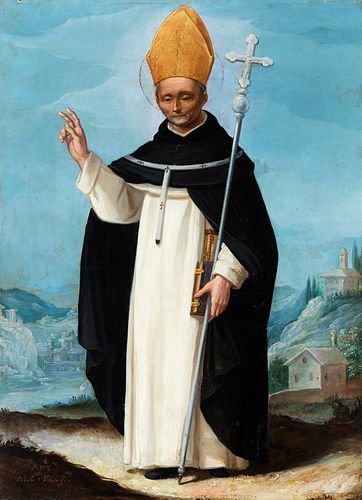Italian or Mexican school; XVIII century. "Saint Thomas of Villanueva". Oil on copper.
Lot 4
About Seller
Setdart Auction House
Carrer Aragó 346
Barcelona
Spain
Setdart Subastas was born in 2004 and is currently the first online art auction in Spain with solidity, prestige and reliability guaranteed by our more than 60,000 users. Setdart has a young, dynamic and enterprising team ready to successfully manage the purchase and sale of art works through custom...Read more
Estimate:
EUR€3,000 - EUR€4,000
$3,225.81 - $4,301.08
Absentee vs Live bid
Two ways to bid:
- Leave a max absentee bid and the platform will bid on your behalf up to your maximum bid during the live auction.
- Bid live during the auction and your bids will be submitted real-time to the auctioneer.
Bid Increments
| Price | Bid Increment |
|---|---|
| EUR€0 | EUR€10 |
| EUR€200 | EUR€25 |
| EUR€500 | EUR€50 |
| EUR€1,000 | EUR€100 |
| EUR€3,000 | EUR€200 |
| EUR€5,000 | EUR€500 |
| EUR€10,000 | EUR€1,000 |
| EUR€20,000 | EUR€2,000 |
| EUR€50,000 | EUR€5,000 |
About Auction
By Setdart Auction House
Oct 20, 2021
Set Reminder
2021-10-20 07:30:00
2021-10-20 07:30:00
America/New_York
Bidsquare
Bidsquare : OLD MASTERS
https://www.bidsquare.com/auctions/setdart-auction-house/old-masters-7700
Setdart Auction House sofia@setdart.com
Setdart Auction House sofia@setdart.com
- Lot Description
Italian or Mexican school; XVIII century. "Saint Thomas of Villanueva". Oil on copper. Presents inscription. Measures: 35 x 25,5 cm. Santo Tomás de Villanueva (1486-1555), was an Augustinian friar and ascetic priest, archbishop of Valencia, as well as advisor and confessor of King Carlos I of Spain, also prior of Salamanca, Burgos and Valladolid. One of his most recognizable iconographic elements are the coins in his hand, which allude to one of his most valued characteristics: his charity towards the poor. In this work the saint is not portrayed performing any miracle, but only shows his presence, standing in the center of the composition, holding his crosier, and making the gesture of blessing. The figure is inscribed in a wide landscape that shows a depression in the ground, which gives great depth to the scene, despite the fact that the horizon marked by the artist is low in relation to the composition. There is a great contrast between the conception of the composition, which is clear, symmetrical and easy to read, with the chromatic range. Which stands out for the use of bright shades, which generate great contrasts between them, such as white, black, blue or gold. This characteristic surely derives from the use of copper as a support for the painting. Stylistically, the proportions of her anatomy, her face and the polychromy place the work within the 18th century, already with a clear influence of Neoclassicism, but still maintaining certain, but slight, characteristics of the Baroque as the aesthetic treatment of the background that composes the image, and the material in which it is made. This mixture of influences was common at the time, but normally, as in this case, the artists tended to lean towards one of the two main currents: either to maintain the tradition, or to embrace the novelties that came from Europe and radiated from centers such as the Royal Academy of Fine Arts of San Fernando in Madrid, or the Academy of Rome.
- Shipping Info
-
In-house shipping available. Please inquire at admin@setdart.com.
-
- Buyer's Premium



 EUR
EUR CAD
CAD AUD
AUD GBP
GBP MXN
MXN HKD
HKD CNY
CNY MYR
MYR SEK
SEK SGD
SGD CHF
CHF THB
THB









